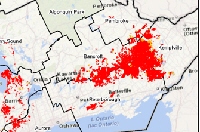Spongy Moths (formerly Gypsy or LDD moths)
Many Otty Lake residents are reporting spongy moth infestations in clusters around the lake. We have assembled some resources to help you identify, respond and hopefully manage these outbreaks. (The name “gypsy moth” is being replaced as it is a derogatory term for the Romani people.)
Web References
Recent References | Summer of 2021 | Ontario 2020 Defoliation | Gypsy Moth Government of Canada Overview | Damage and Much More | Life Cycle | Enemies | Viral and Fngal Disease | Long Term Effects of Spraying |
Resident Experiences
Health Impacts | Some Facts by Derek Smith | Monitoring the Situation (Gail Read) | Landowners Plead for Hep | Ontario Today Program | Dan Woods Notes | Making Your Own Traps (Dan Woods and Tineke Doornbosch) | Lanark County Brochure |
Webinars
Gypsy (Ldd) Moth Status Webinar, June 10, 2021 by the Eastern Ontario Model Forest (EOMF) and Ontario Woodlot Association (OWA). Access the recording.
Gypsy Moth and the Summer of 2021:
What to expect, and what to do
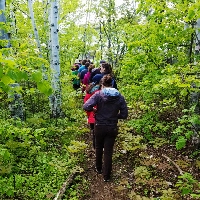 An update from:
An update from:
Government of Canada: Gypsy Moth Overview
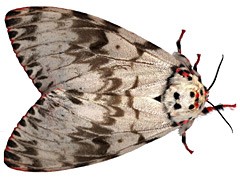 A good introduction to Gypsy Moths however Btk is now thought to impact ALL Lepidoptera (moths and caterpillars) as well as cause birds to leave.
A good introduction to Gypsy Moths however Btk is now thought to impact ALL Lepidoptera (moths and caterpillars) as well as cause birds to leave.
A concern because the larvae feed voraciously, mostly on the leaves of deciduous (leafy) trees, but also on some conifers (evergreens). During the larval stage, a single gypsy moth caterpillar can eat an average of one square metre of leaves.
University of Illinois Extension: Damage and Much More
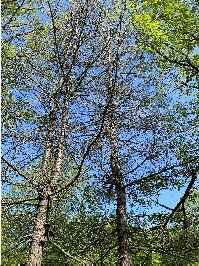 The larva or caterpillar is the damaging stage as it eats the leaves of trees in the spring. They can consume tremendous amounts of leaf material, as much as one square foot of leaves per day. Consistent or repeated defoliation over several years can lead to tree stress and death.
The larva or caterpillar is the damaging stage as it eats the leaves of trees in the spring. They can consume tremendous amounts of leaf material, as much as one square foot of leaves per day. Consistent or repeated defoliation over several years can lead to tree stress and death.
Life Cycle
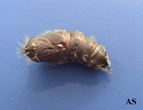 | 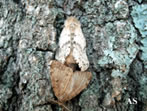 |
This website provides information and advice. Gypsy moths are nasty pests. They eat the leaves off of trees and are always on the move. If they haven’t bothered you yet, they may next year.
Rosocommon County Michigan: Natural Enemies of the Gypsy Moth
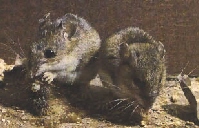 | 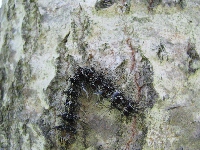 |
Gypsy moths have a variety of predators including mice, chipmunks, squirrels, skunks, raccoons, and many species of birds. Sadly, they can’t keep up. Caterpillars can be killed by a virus and fungus as well.
Michigan State University: A Viral and Fungal Disease…..Cause Collapse
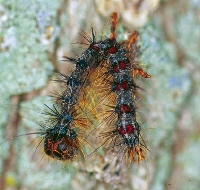 During gypsy moth outbreaks, caterpillar density can be so high that some trees may be completely stripped of leaves by mid-summer. Outbreaks of gypsy moth populations usually collapse after two to four years. This is partly because of the natural enemies.
During gypsy moth outbreaks, caterpillar density can be so high that some trees may be completely stripped of leaves by mid-summer. Outbreaks of gypsy moth populations usually collapse after two to four years. This is partly because of the natural enemies.
West Virginia University: Long Term Effects of Btk and Gypchek
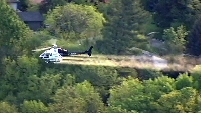 A very thorough and unbiased evaluation of the various possible control methods and their impact on non-target organisms. This study confirms that spraying Btk has a significant impact on non-target Lepidoptera spp (refer to insect chapter) as well as a significant impact on bird populations. Gypchek does not.
A very thorough and unbiased evaluation of the various possible control methods and their impact on non-target organisms. This study confirms that spraying Btk has a significant impact on non-target Lepidoptera spp (refer to insect chapter) as well as a significant impact on bird populations. Gypchek does not.
Resident Experiences
Health Impacts
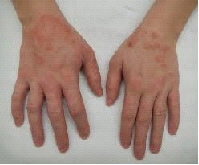 Many people have experienced a gypsy moth rash 8 – 10 hours after exposure to the egg masses. The rash lasts about a week. Those with severe allergies or asthma, or children who may be more actively handling the caterpillars, should exercise caution.
Many people have experienced a gypsy moth rash 8 – 10 hours after exposure to the egg masses. The rash lasts about a week. Those with severe allergies or asthma, or children who may be more actively handling the caterpillars, should exercise caution.
Some Facts About Gypsy Moths
By Derek Smith
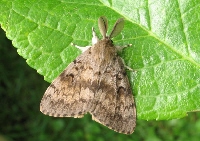 Gypsy moths are an invasive and terribly damaging species. During an average year they deforest a million acres of hardwood forest across North East Canada and the United States. Deforestation weakens trees and leaves them susceptible to disease.
Gypsy moths are an invasive and terribly damaging species. During an average year they deforest a million acres of hardwood forest across North East Canada and the United States. Deforestation weakens trees and leaves them susceptible to disease.
The life cycle of gypsy moths consists of an egg, caterpillar, pupa and moth stage. Gypsy moth caterpillars (see photo) appeared on my trees in early July this year. They are 5-6 centimeters long and very distinctive with bristles and two lines of red spots down their back. They are prolific and I destroyed hundreds of them. By early August the caterpillar stage finished and after a brief pupa stage our woods were filled with small moths. The females are as dull white colour and can’t fly (see photo). The males (see photo) are smaller, a light brown colour and they flit through the trees low to the ground in an erratic flight pattern. The females emit a pheromone which attracts the males.
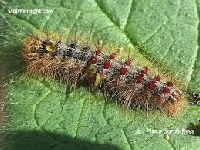 | 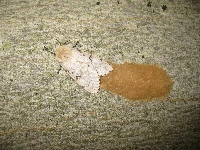 |
Females prefer to lay eggs on hardwood trees (oak, maple, birch, ironwood) but we found eggs on beech and even occasionally on white pine. Each tan colored egg mass (see photo) contains between 600 and 1000 eggs. The egg masses are easy to identify and usually found 1-3 metres from the ground. Eggs are dormant through the winter and hatch in late April or early May with warmer temperatures and the production of new tender foliage.
To date, we have identified and sprayed over 700 egg masses on 50 acres of our properties on Baxter Lane. I understand that a problem has also been identified in Burgess Woods. One caterpillar will eat an average of 1 square metre of leaves during its lifetime. Imagine the deforestation potential of 420,000 to 700,000 caterpillars!
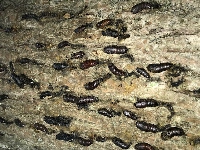 | 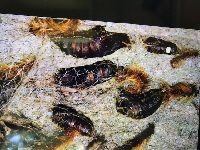 |
There are several ways to kill gypsy moth egg masses. 1) Scrap the eggs off of the tree trunk into a paper bag and then burn the bag. 2) Spray and saturate the egg masses with a “horticultural oil” product. The oil and sprayer are inexpensive and are available at Home Hardware or any garden center. Or, 3) Spray the egg masses with an insecticide such as Household Raid. I have used both oil and Raid and will report on their effectiveness in the spring.
Gypsy moth infestations occur every 7-10 years. Next summer may well be one of those years. Please inspect your trees and destroy all the egg masses you find.
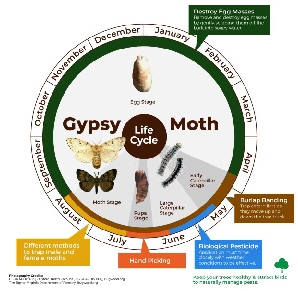
Monitoring the Gypsy Moth Situation on Otty Lake
Submitted by Gail Read in conversation with resident scientists
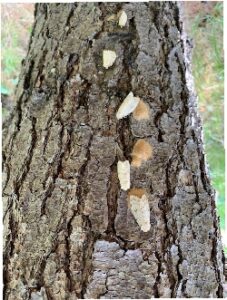 It is too late this year to control the gypsy moth situation as both Btk and Gypchek sprays have to be applied soon after the eggs hatch; currently the population is in late larva to adult stage (e.g. a lot of flying male moths). If we are lucky, the virus will cause the population to collapse as we are at a high point in the natural cycle.
It is too late this year to control the gypsy moth situation as both Btk and Gypchek sprays have to be applied soon after the eggs hatch; currently the population is in late larva to adult stage (e.g. a lot of flying male moths). If we are lucky, the virus will cause the population to collapse as we are at a high point in the natural cycle.
The gypsy moth activity is now dwindling but the egg masses are quietly lying dormant on our trees. Those that are within reach with a ladder should be eradicated. Of course areas vary significantly around Otty Lake but there appear to be a significant number of high egg masses in several areas. With egg masses each containing 100-1000 potential small caterpillars, this could be very serious.
A careful survey of the number of females/egg masses and the number of zombie caterpillars vs. healthy caterpillars this year may be informative. Hopefully we can predict what will happen next year by making observations and taking action on our properties. A comprehensive view of the facts is needed to cause the government to take a serious look at our situation and possibly make policy decisions. There are no promises but without data, our situation is only a plea.
The tasks:
How many ‘zombie’ caterpillars are you able to find vs. normal caterpillars?
The ‘V-shaped’ wet caterpillars are dead from virus.
Straight heads pointing down and dry, stiff caterpillars are dead from pathogenic fungus.
Document your results. [We need raw numbers of both infected and uninfected individuals to estimate a ratio, and the strength of the estimate is in part determined by the absolute numbers surveyed.]
Count how many egg masses are in a given area, and how many trees you have with egg masses vs. trees you have without egg masses.
Document your results.
NB. Now crush, scrape or oil the egg masses with care!!
Interpreting your results:
Virus-killed caterpillars can indicate that there is a natural ‘crash’ occurring in the population and that there will be fewer gypsy moths next year.
Action: Leave caterpillar carcasses in place as virus ridden spores can spread.
Action: Destroy all females and egg masses.
Action: Consider the numbers of egg masses to determine further actions.
Fungus-killed caterpillars are less informative, as the prevalence of fungus depends on the weather conditions (wet weather with warmer temperatures).
Action: Destroy all females and egg masses.
Action: Consider the numbers of egg masses to determine further actions.
Large numbers of egg masses are indicative of a large Gypsy Moth outbreak in the coming year.
Action: Destroy all females and egg masses.
Action: Consider the possibility of spraying in the spring as the caterpillars hatch, using Gypchek if available.
Working Your Property to Control the Situation:
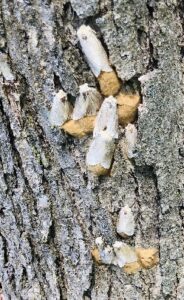 Local control is definitely worthwhile. It can be a time-consuming process but investing in our environment is always a worthwhile endeavour. Work wisely and efficiently!
Local control is definitely worthwhile. It can be a time-consuming process but investing in our environment is always a worthwhile endeavour. Work wisely and efficiently!
Kill larvae, the pupae stage, to prevent the reproduction of the gypsy moths.
This can protect individual trees.
Watch for the silken threads that attach them to your trees. Female moths don’t fly so will settle near their pupae.
The biggest larvae are females, but that’s a difficult distinction!
Kill every female moth and egg-mass that you see by scraping, crushing, coating with dormant oil.
Raid or other insecticides work but are overkill and also hit non-target organisms
Killing males is a waste of time
A 99% kill rate still leaves enough male moths to fertilize all available females.
This is also applicable to pheromone traps which only kill males but never 100% of them. As a result, it gives you a false sense of accomplishment.
Broadcast aerial spraying is a last resort.
Spraying may actually prolong an epidemic, postponing a ‘collapse’ caused by natural pathogens (as demonstrated in the spraying for Eastern Spruce Budworm in New Brunswick where numbers remained high but insufficient to allow for a natural collapse).
The process must be carefully timed when the caterpillars are at an early stage to have an impact. Otherwise, it is just a waste of time, money and resources.
Spraying can have significant impact on non-target organisms, as it blankets the region (including other moths, butterflies, birds and more).
If spraying is justified by the situation, choose the most specific biocide, e.g., Gypchek for this species.
Hopefully, many areas of the lake will rally to the gypsy moth infestation. By working together with data, the best of decisions can be made and egg masses will be minimized.
Landowners plead for help halting caterpillar invasion
 Stu Mills did a CBC story on the gypsy moth infestation. It provides good coverage of the Otty Lake situation and beyond, with reference to the Hwy 7 corridor. Dan Woods offered a tour of his Otty Lake property in Tay Valley Township for the story.
Stu Mills did a CBC story on the gypsy moth infestation. It provides good coverage of the Otty Lake situation and beyond, with reference to the Hwy 7 corridor. Dan Woods offered a tour of his Otty Lake property in Tay Valley Township for the story.
Gypsy moth caterpillars reduce trees to twigs
 Ontario Today radio call-in program, with guest Paul Robertson, President of the Ontario Woodlot Association Paul Robertson. 52 minutes.
Ontario Today radio call-in program, with guest Paul Robertson, President of the Ontario Woodlot Association Paul Robertson. 52 minutes.
Letter from Dan Woods – June 25, 2020
 A letter from Dan to his Burgess Wood neighbours about the gypsy moth infestation in their neighbourhood.
A letter from Dan to his Burgess Wood neighbours about the gypsy moth infestation in their neighbourhood.
Making Your Own Traps
Our Commercial Pheromone Traps Worked.
… But not as well as the traps you can make yourself!!
by Dan Woods & Tineke Doornbosch , 14 July 2020
The 5 pheromone traps we purchased were quickly overwhelmed by the sheer numbers on our property. In a word, the traps we purchased were underwhelmingly inefficient.
Here are some cost-effective alternatives you may wish to try:
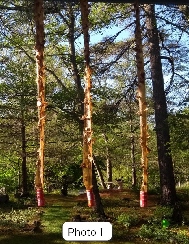 a. (Photo 1) “Fly Ribbon” from Canadian Tire or Home Hardware. (It’s the ugly ribbon our parents and grand-parents often used in our homes when we were younger.) It’s still ugly.. but the moths love it. If you do not have a commercial pheromone lure, simply find a couple of white females and stick them to the glue. Your trap is now ready to go. It’ll take less than a day to fill your ribbon with unlucky moths.
a. (Photo 1) “Fly Ribbon” from Canadian Tire or Home Hardware. (It’s the ugly ribbon our parents and grand-parents often used in our homes when we were younger.) It’s still ugly.. but the moths love it. If you do not have a commercial pheromone lure, simply find a couple of white females and stick them to the glue. Your trap is now ready to go. It’ll take less than a day to fill your ribbon with unlucky moths.b. (Photo 2) A roll of fly paper costs about $9 for a 30 foot roll. Cut out the bottom if any 2-3 litre plastic tub and tape the paper to the inside of the container. Use a commercial pheromone lure…or prime it with a couple of unlucky female gypsy moths. Hang it on your favourite tree. In about a day, this too will be filled. And if you have them in your garage, put some sticky paper on the inside of your garage window (sticky side out!!)
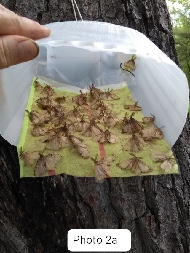
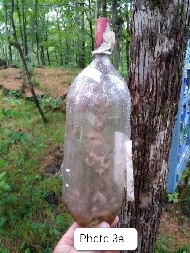
c. (Photo 3) Find any plastic jug (a 2-litre pop bottle works well) Put an inch of soapy water in the bottom. Cut out a couple of slots for the moths to enter. Pull out a length pf fly ribbon, bait the ribbon with a couple of female gypsies or a purchased pheromone lure), place it into the jug, seal the top with the ribbon cartridge…then hang it in a tree. Another trap is set!
3. Happy hunting!
Lanark County Publications
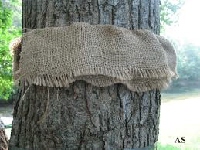 Two sided brochure: Destructive Pests: Best Management Practices
Two sided brochure: Destructive Pests: Best Management Practices
Six page backgrounder discusses control measures for residents.

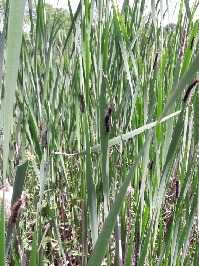 A Harsh Year of Gypsy Moth Action on Otty Lake
A Harsh Year of Gypsy Moth Action on Otty Lake